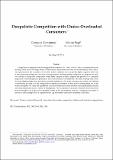Files in this item
Duopolistic competition with choice-overloaded consumers
Item metadata
| dc.contributor.author | Gerasimou, Georgios | |
| dc.contributor.author | Papi, Mauro | |
| dc.date.accessioned | 2019-10-01T23:37:25Z | |
| dc.date.available | 2019-10-01T23:37:25Z | |
| dc.date.issued | 2018-01 | |
| dc.identifier | 251387453 | |
| dc.identifier | 12c110cb-ec05-4a1d-975f-a77787661742 | |
| dc.identifier | 85033579846 | |
| dc.identifier | 000424716600017 | |
| dc.identifier.citation | Gerasimou , G & Papi , M 2018 , ' Duopolistic competition with choice-overloaded consumers ' , European Economic Review , vol. 101 , pp. 330-353 . https://doi.org/10.1016/j.euroecorev.2017.10.002 | en |
| dc.identifier.issn | 0014-2921 | |
| dc.identifier.other | ORCID: /0000-0003-3712-3154/work/59698752 | |
| dc.identifier.uri | https://hdl.handle.net/10023/18597 | |
| dc.description.abstract | A large body of empirical work has suggested the existence of a “choice overload” effect in consumer decision making: when faced with large menus of alternatives, decision makers often avoid/indefinitely defer choice. An explanation for the occurrence of this effect is that consumers try to escape the higher cognitive effort that is associated with making an active choice in large menus. Building on this explanation, we propose and analyse a model of duopolistic competition where firms compete in menu design in the presence of a consumer population with heterogeneous preferences and overload menu-size thresholds. The firms’ strategic trade-off is between offering a large menu in order to match the preferences of as many consumers as possible, and offering a small menu in order to avoid losing choice-overloaded consumers to their rival or driving them out of the market altogether. We study the equilibrium outcomes in this market and establish some (im)possibility results and characterizations under a variety of assumptions. We also propose a measure of market effectiveness that may be thought of as a proxy for consumer welfare in this environment, and use it alongside our model to provide a critical perspective on regulations that cap the number of products that firms could offer. | |
| dc.format.extent | 1349607 | |
| dc.language.iso | eng | |
| dc.relation.ispartof | European Economic Review | en |
| dc.subject | Choice overload | en |
| dc.subject | Bounded rationality | en |
| dc.subject | Duopolistic competition | en |
| dc.subject | Behavioural industrial organization | en |
| dc.subject | HB Economic Theory | en |
| dc.subject | NDAS | en |
| dc.subject | BDC | en |
| dc.subject | R2C | en |
| dc.subject.lcc | HB | en |
| dc.title | Duopolistic competition with choice-overloaded consumers | en |
| dc.type | Journal article | en |
| dc.contributor.institution | University of St Andrews. School of Economics and Finance | en |
| dc.identifier.doi | 10.1016/j.euroecorev.2017.10.002 | |
| dc.description.status | Peer reviewed | en |
| dc.date.embargoedUntil | 2019-10-02 |
This item appears in the following Collection(s)
Items in the St Andrews Research Repository are protected by copyright, with all rights reserved, unless otherwise indicated.

